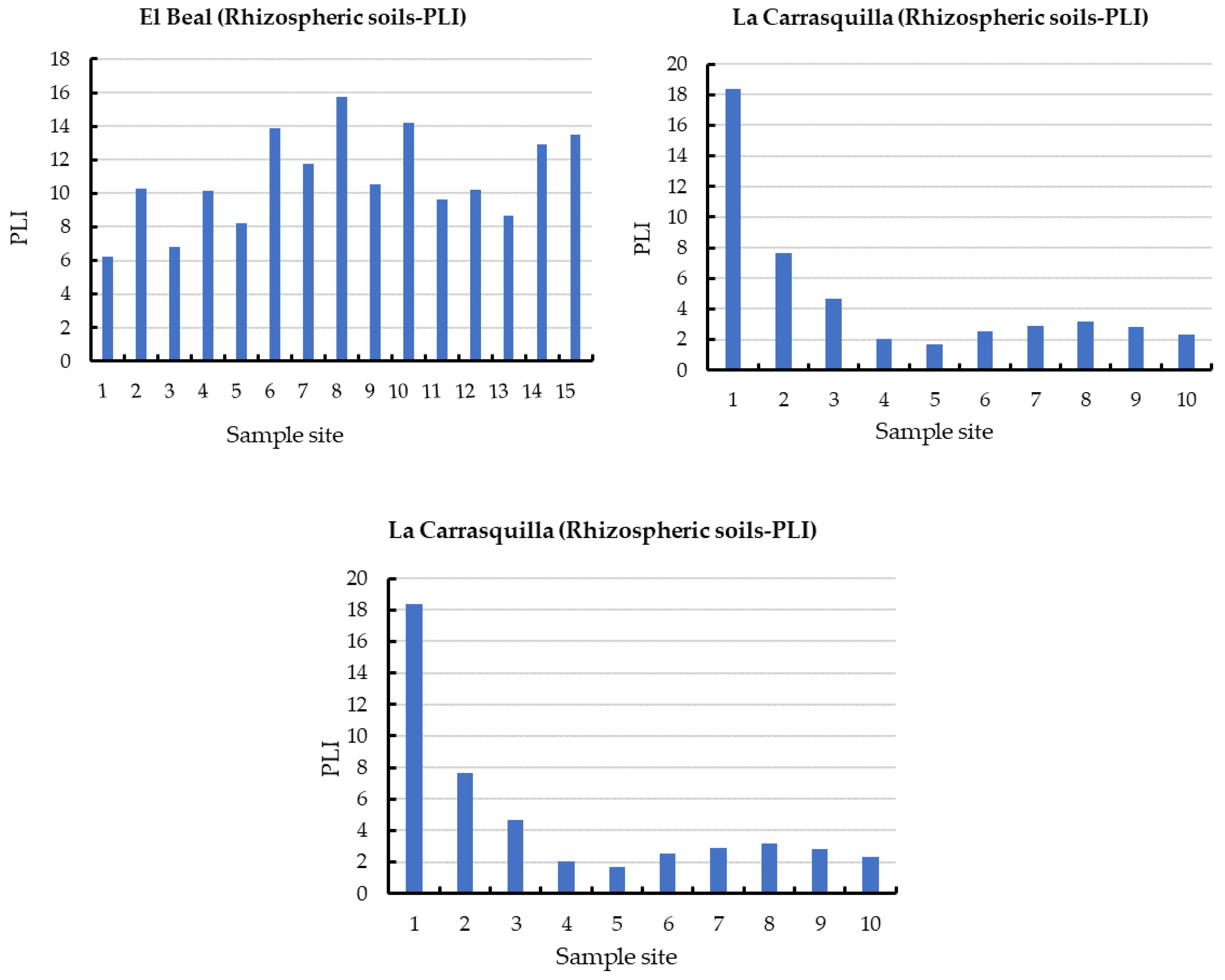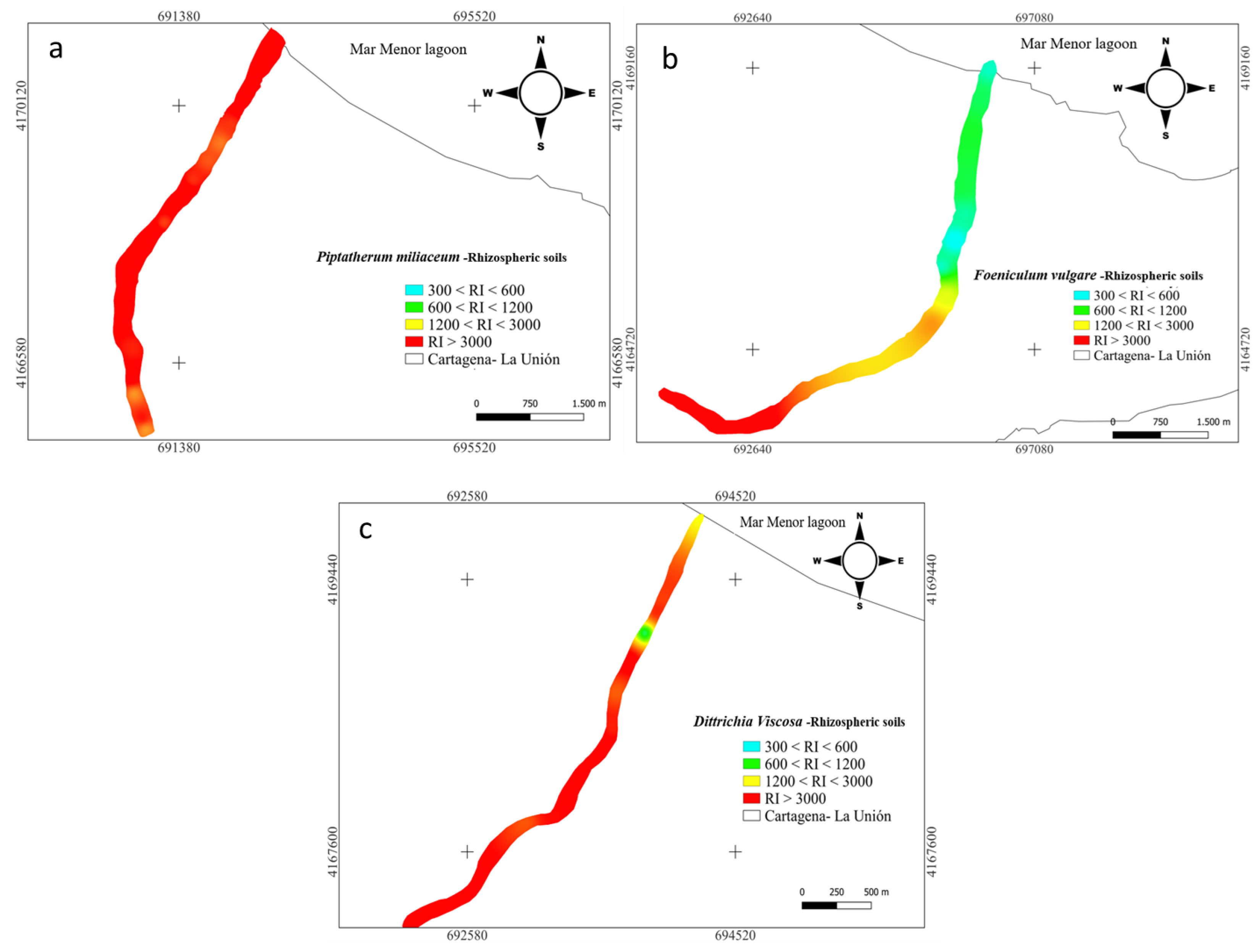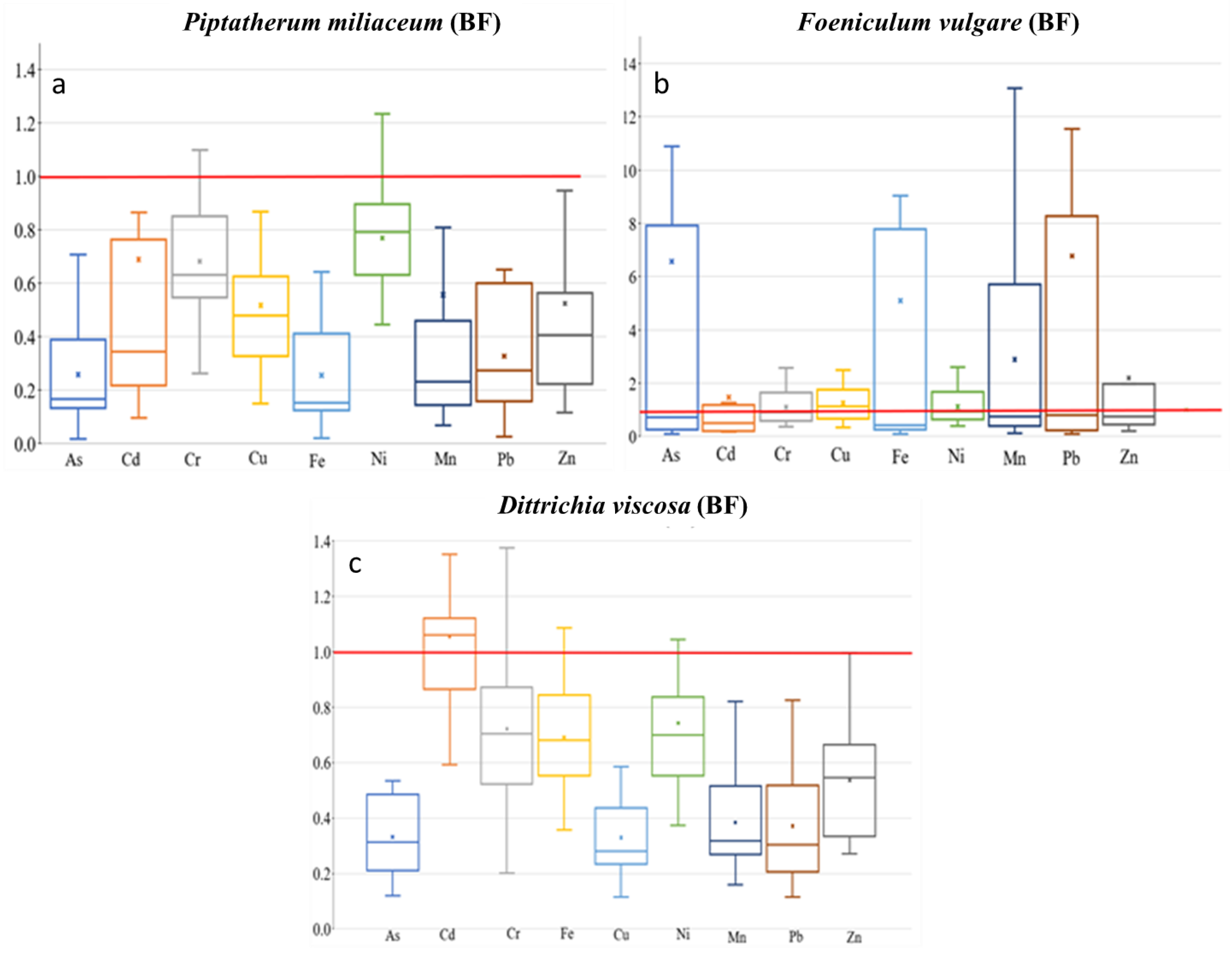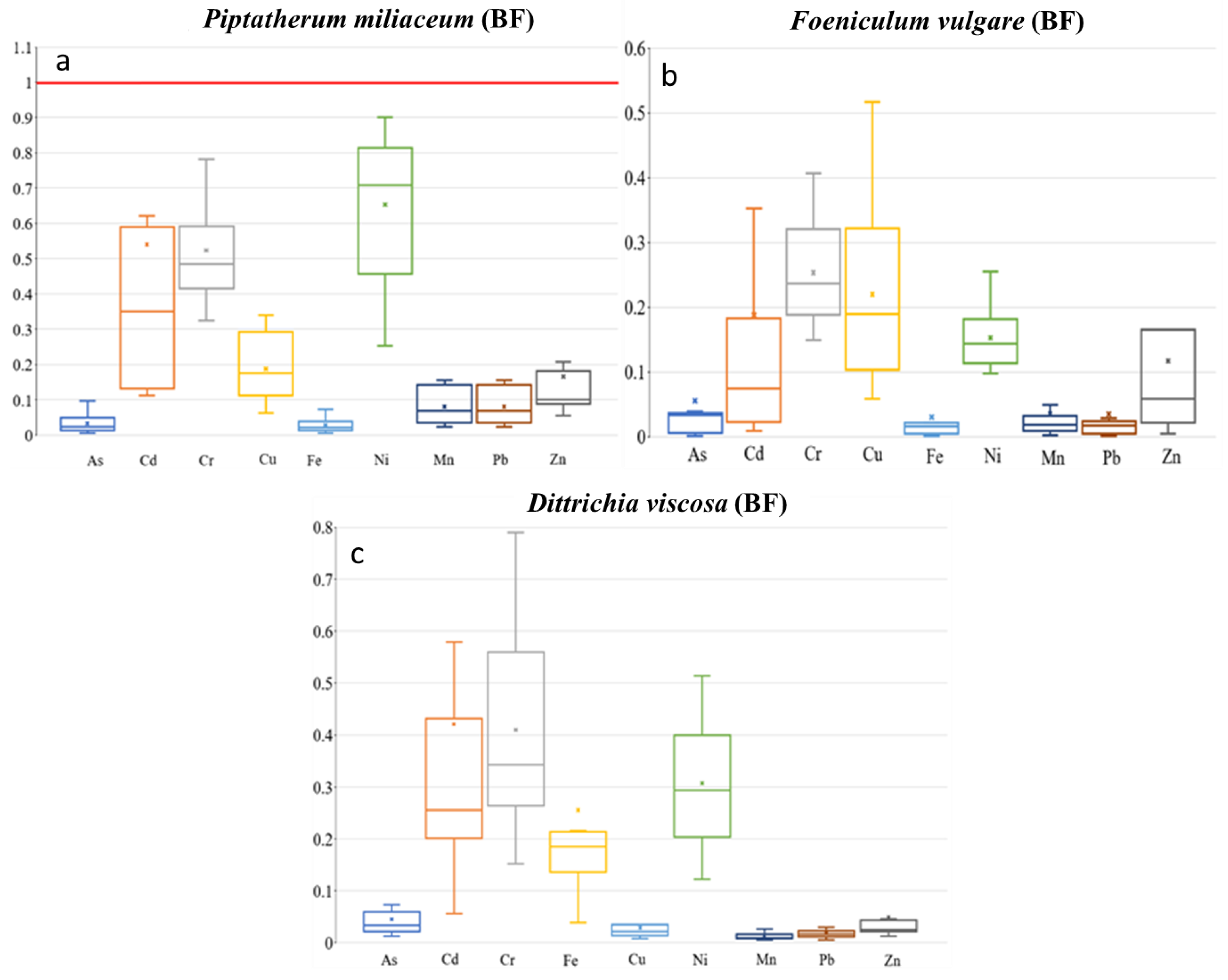Bio-Monitoring of Metal(loid)s Pollution in Dry Riverbeds Affected by Mining Activity
Abstract
:1. Introduction
2. Materials and Methods
2.1. Study Area
2.2. Sampling Collection
2.3. Rhizospheric Soil Analyses
2.4. Plant Analyses
2.5. Metal(loid) Concentration Indices
2.5.1. Contamination Factor
2.5.2. Pollution Load Index
2.5.3. Potential Ecological Risk Index
2.5.4. Bioaccumulation Factor (BF)
2.5.5. Translocation Factor (TF)
2.5.6. Mobility Ratio (MR)
2.5.7. Statistical and Geostatistical Analysis
3. Results and Discussion
3.1. Behavior of Piptatherum miliaceum
3.1.1. Rhizospheric Soil Characterization
3.1.2. Root–Stem Characterization
3.2. Behavior of Foeniculum vulgare
3.2.1. Rhizospheric Soil Characterization
3.2.2. Root–Stem Characterization
3.3. Behavior of Dittrichia viscosa
3.3.1. Rhizospheric Soil Characterization
3.3.2. Root–Stem Characterization
4. Conclusions
Supplementary Materials
Author Contributions
Funding
Data Availability Statement
Conflicts of Interest
References
- Stankovic, S.; Stankovic, A.R. Bioindicators of toxic metals. In Green Materials for Energy, Products and Depollution; Springer: Dordrecht, The Netherlands, 2013; pp. 151–228. [Google Scholar] [CrossRef]
- Siddig, A.A.H.; Aaron, M.; Ellison, A.; Ochs, A.; Villar-Leeman, C.; Lau, M.K. How do ecologists select and use indicator species to monitor ecological change? Insights from 14 years of publication in Ecological Indicators. Ecol. Indic. 2016, 60, 223–230. [Google Scholar] [CrossRef]
- Doganlar, Z.B.; Doganlar, O.; Erdogan, S.; Onal, Y. Heavy metal pollution and physiological changes in the leaves of some shrub, palm and tree species in urban areas of Adana, Turkey. Chem. Speciat. Bioavailab. 2012, 24, 65–78. [Google Scholar] [CrossRef]
- Bharti, S.K.; Trivedi, A.; Kumar, N. Air pollution tolerance index of plants growing near an industrial site. Urban Clim. 2018, 24, 820–829. [Google Scholar] [CrossRef]
- Turkyilmaz, A.; Sevik, H.; Cetin, M. The use of perennial needles as biomonitors for recently accumulated heavy metals. Landsc. Ecol. Eng. 2018, 14, 115–120. [Google Scholar] [CrossRef]
- Fermo, P.; Masiero, S.; Rosa, M.; Labella, G.; Comite, V. Chlorophytum comosum: A Bio-Indicator for Assessing the Accumulation of Heavy Metals Present in The Aerosol Particulate Matter (PM). Appl. Sci. 2021, 11, 4348. [Google Scholar] [CrossRef]
- Serbula, S.M.; Kalinovic, T.S.; Ilic, A.A.; Kalinovic, J.V.; Steharnik, M.M. Assessment of Airborne Heavy Metal Pollution Using Pinus spp. and Tilia spp. Aerosol Air Qual. Res. 2013, 13, 563–573. [Google Scholar] [CrossRef]
- Rodriguez, J.; Wannaz, E.; Salazar, M.; Pignata, M.; Fangmeier, A.; Franzaring, J. Accumulation of polycyclic aromatic hydrocarbons and heavy metals in the tree foliage of Eucalyptus rostrata, Pinus radiata and Populus hybridus in the vicinity of a large aluminium smelter in Argentina. Atmos. Environ. 2012, 55, 35–42. [Google Scholar] [CrossRef]
- Zeidler, M. Heavy metals in two herb species (river Morava, Czech Republic). Pol. J. Ecol. 2005, 53, 185–195. [Google Scholar]
- Parmar, T.K.; Rawtani, D.; Agrawal, Y.K. Bioindicators: The natural indicator of environmental pollution. Front. Life Sci. 2016, 9, 110–118. [Google Scholar] [CrossRef]
- Li, Z.Y.; Ma, Z.W.; van der Kuijp, T.J.; Yuan, Z.W.; Huang, L. A review of soil heavy metal pollution from mines in China: Pollution and health risk assessment. Sci. Total Environ. 2014, 468–469, 843–853. [Google Scholar] [CrossRef]
- Zrnčić, S.; Oraić, D.; Ćaleta, M.; Mihaljević, Ž.; Zanella, D.; Bilandžić, N. Biomonitoring of heavy metals in fish from the Danube River. Environ. Monit. Assess. 2013, 185, 1189–1198. [Google Scholar] [CrossRef] [PubMed]
- Shaheen, S.M.; Hooda, P.S.; Tsadilas, C.D. Opportunities and challenges in the use of coal fly ash for soil improvements–A review. J. Environ. Manag. 2014, 145, 249–267. [Google Scholar] [CrossRef]
- Schat, H.; Llugany, M.; Bernhard, R. Metal-specific patterns of tolerance, uptake, and transport of heavy metals in hyperaccumulating and nonhyperaccumulating metallophytes. In Phytoremediation of Contaminated Soil and Water; CRC Press: Boca Raton, FL, USA, 2020; pp. 171–188. [Google Scholar] [CrossRef]
- Conesa, H.M.; Schulin, R.; Nowack, B. A Laboratory Study on Revegetation and Metal Uptake in Native Plant Species from Neutral Mine Tailings. Water Air Soil Pollut. 2007, 183, 201–212. [Google Scholar] [CrossRef]
- García, G.; Faz, Á.; Cunha, M. Performance of Piptatherum miliaceum (Smilo grass) in edaphic Pb and Zn phytoremediation over a short growth period. Int. Biodeterior. Biodegrad. 2004, 54, 245–250. [Google Scholar] [CrossRef]
- Mykolenko, S.; Liedienov, V.; Kharytonov, M.; Makieieva, N.; Kuliush, T.; Queralt, I.; Marguí, E.; Hidalgo, M.; Pardini, G.; Gispert, M. Presence, mobility and bioavailability of toxic metal(oids) in soil, vegetation and water around a Pb-Sb recycling factory (Barcelona, Spain). Environ. Pollut. 2018, 237, 569–580. [Google Scholar] [CrossRef] [PubMed]
- Pérez-Sirvent, C.; Martínez-Sánchez, M.J.; Martínez-López, S.; Bech, J.; Bolan, N. Distribution and bioaccumulation of arsenic and antimony in Dittrichia viscosa growing in mining-affected semiarid soils in southeast Spain. J. Geochem. Explor. 2012, 123, 128–135. [Google Scholar] [CrossRef]
- Marchiol, L.; Fellet, G.; Boscutti, F.; Montella, C.; Mozzi, R.; Guarino, C. Gentle remediation at the former “Pertusola Sud” zinc smelter: Evaluation of native species for phytoremediation purposes. Ecol. Eng. 2013, 53, 343–353. [Google Scholar] [CrossRef]
- Pistelli, L.; D’angiolillo, F.; Morelli, E.; Basso, B.; Rosellini, I.; Posarelli, M.; Barbafieri, M. Response of spontaneous plants from an ex-mining site of Elba island (Tuscany, Italy) to metal(loid) contamination. Environ. Sci. Pollut. Res. 2017, 24, 7809–7820. [Google Scholar] [CrossRef]
- Gonzalez-Fernandez, O.; Queralt, I.; Manteca, J.I.; Garcia, G.; Carvalho, M.L. Distribution of metals in soils and plants around mineralized zones at Cartagena-La Unión mining district (SE, Spain). Environ. Earth Sci. 2011, 63, 1227–1237. [Google Scholar] [CrossRef]
- Oen, I.S.; Fernandez, J.C.; Manteca, J.I. The lead-zinc and associated ores of La Union, Sierra de Cartagena, Spain. Econ. Geol. 1975, 70, 1259–1278. [Google Scholar] [CrossRef]
- Zornoza, R.; Carmona, D.M.; Acosta, J.A.; Martínez-Martínez, S.; Weiss, N.; Faz, Á. The effect of former mining activities on contamination dynamics in sediments, surface water and vegetation in El Avenque stream, SE Spain. Water Air Soil Pollut. 2012, 223, 519–532. [Google Scholar] [CrossRef]
- Cuevas, J.G.; Faz, A.; Martínez-Martínez, S.; Gabarrón, M.; Beltrá, J.C.; Martínez, J.; Acosta, J.A. Spatial distribution and pollution evaluation in dry riverbeds affected by mine tailings. Environ. Geochem. Health 2023, 1–17. [Google Scholar] [CrossRef]
- Martínez-López, S.; Martínez-Sánchez, M.J.; Gómez-Martínez, M.d.C.; Pérez-Sirvent, C. Assessment of the risk associated with mining-derived arsenic inputs in a lagoon system. Environ. Geochem. Health 2020, 42, 2439–2450. [Google Scholar] [CrossRef]
- Álvarez-Rogel, J.; Carrasco, L.; Marín, C.; Martínez-Sánchez, J. Soils of a dune coastal salt marsh system in relation to groundwater level, micro-topography and vegetation under a semiarid Mediterranean climate in SE Spain. Catena 2007, 69, 111–121. [Google Scholar] [CrossRef]
- Parraga-Aguado, I.; Gonzalez-Alcaraz, M.N.; Alvarez-Rogel, J.; Jimenez-Carceles, F.J.; Conesa, H.M. The importance of edaphic niches and pioneer plant species succession for the phytomanagement of mine tailings. Environ. Pollut. 2013, 176, 134–143. [Google Scholar] [CrossRef] [PubMed]
- Conesa, H.M.; Faz, Á.; García, G.; Arnaldos, R.; Llona, M. Recuperación y/o estabilización de los terrenos mineros de La Unión-Cartagena (Murcia) mediante la revegetación con especies mediterráneas. In Patrimonio Geológico y Minero y Desarrollo Regional; IGME: Madrid, Spain, 2003; pp. 315–320. [Google Scholar]
- Levine, S.; Rudnick, D.; Kelly, J.; Morton, R.; Buttel, L.; Carr, K. Pollutant dynamics as influenced by seagrass beds: Experiments with tributyltin in thalassia microcosms. Mar. Environ. Res. 1990, 30, 297–322. [Google Scholar] [CrossRef]
- Rahimi, R.; Ardekani, M.R.S. Medicinal properties of Foeniculum vulgare Mill. in traditional Iranian medicine and modern phytotherapy. Chin. J. Integr. Med. 2012, 19, 73–79. [Google Scholar] [CrossRef]
- Parthasarathy, V.A.; Chempakam, B.; Zachariah, T.J. (Eds.) Chemistry of Spices; Cabi: London, UK, 2008. [Google Scholar]
- Rasul, A.; Akhtar, N.; Khan, B.A.; Mahmood, T.; Zaman, S.U.; Khan, H.M. Formulation development of a cream containing fennel extract: In vivo evaluation for anti-aging effects. Die Pharm.-Int. J. Pharm. Sci. 2012, 67, 54–58. [Google Scholar] [CrossRef]
- Senatore, F.; Oliviero, F.; Scandolera, E.; Taglialatela-Scafati, O.; Roscigno, G.; Zaccardelli, M.; De Falco, E. Chemical composition, antimicrobial and antioxidant activities of anethole-rich oil from leaves of selected varieties of fennel [Foeniculum vulgare Mill. ssp. vulgare var. azoricum (Mill.) Thell]. Fitoterapia 2013, 90, 214–219. [Google Scholar] [CrossRef]
- Fathima, F. Investigation of Heavy Metal Content in Selected Top Traded Medicinal Plants Collected from Different Sources. Ph.D. Thesis, RGUHS, Bangalore, India, 2011. [Google Scholar]
- Araniti, F.; Lupini, A.; Sunseri, F.; Abenavoli, M.R. Allelopatic Potential of Dittrichia viscosa (L.) W. Greuter Mediated by VOCs: A Physiological and Metabolomic Approach. PLoS ONE 2017, 12, e0170161. [Google Scholar] [CrossRef]
- Parolin, P.; Ion Scotta, M.I.; Bresch, C. Biology of Dittrichia viscosa, a Mediterranean ruderal plant: A review. Phyton 2014, 83, 251–262. [Google Scholar] [CrossRef]
- Stavrianakou, S.; Liakopoulos, G.; Karabourniotis, G. Boron deficiency effects on growth, photosynthesis and relative concentrations of phenolics of Dittrichia viscosa (Asteraceae). Environ. Exp. Bot. 2006, 56, 293–300. [Google Scholar] [CrossRef]
- Bresch, C.; Mailleret, L.; Muller, M.M.; Poncet, C.; Parolin, P. Invasive plants in the Mediterranean basin: Which traits do they share. J. Mediterr. Ecol. 2013, 12, 13–19. [Google Scholar]
- Conesa, H.; María-Cervantes, A.; Álvarez-Rogel, J.; González-Alcaraz, M. Influence of soil properties on trace element availability and plant accumulation in a Mediterranean salt marsh polluted by mining wastes: Implications for phytomanagement. Sci. Total Environ. 2011, 409, 4470–4479. [Google Scholar] [CrossRef]
- Soil Survey Division Staff. Division of Soil Survey. In Soil Survey Manual (No. 18); U.S. Department of Agriculture: Washington, DC, USA, 1993. [Google Scholar]
- Casanellas, J.P.; Requerin, M.L.A.; Ochoa, R.R. Técnicas y Experimentos en Edafología; Romanyá/Valls: Barcelona, Spain, 1986. [Google Scholar]
- EPA. Microwave-Assisted Acid Digestion of Siliceous and Organically Based Matrices. OHW, Method, 3052; Environmental Science & Technology: Washington, DC, USA, 1996. [Google Scholar]
- Lindsay, W.L.; Norvell, W.A. Development of a DTPA soil test for zinc, iron, manganese, and copper. Soil Sci. Soc. Am. J. 1978, 42, 421–428. [Google Scholar] [CrossRef]
- FIMRT. Certificate Reference Material Catalogue; Federal Institute for Material Research and Testing: Berlin, Germany, 2010. [Google Scholar]
- Håkanson, L. An ecological risk index for aquatic pollution control. A sedimentological approach. Water Res. 1980, 14, 975–1001. [Google Scholar] [CrossRef]
- Varol, M. Assessment of heavy metal contamination in sediments of the Tigris River (Turkey) using pollution indices and multivariate statistical techniques. J. Hazard. Mater. 2011, 195, 355–364. [Google Scholar] [CrossRef]
- Martínez-Sánchez, M.J.; Pérez-Sirvent, C. Niveles de Fondo y Niveles Referencia de Metales Pesados en Suelos de la Región de Murcia; Universidad de Murcia y Consejería de Desarrollo Sostenible y Ordenación del Territorio: Murcia, Spain, 2007; p. 306. [Google Scholar]
- Ministére de l’Environmement du Québec. Politique de Protection des Sols et de Réhabilitation des Terrains Contaminés; Publications of the MEQ, Collection Terrains Contaminés: Quebec, QC, Canada, 2001. [Google Scholar]
- Tomlinson, D.L.; Wilson, J.G.; Harris, C.R.; Jeffrey, D.W. Problems in the assessment of heavy-metal levels in estuaries and the formation of a pollution index. Helgoländer Meeresunters 1980, 33, 566–575. [Google Scholar] [CrossRef]
- Yi, Y.; Yang, Z.; Zhang, S. Ecological risk assessment of heavy metals in sediment and human health risk assessment of heavy metals in fishes in the middle and lower reaches of the Yangtze River basin. Environ. Pollut. 2011, 159, 2575–2585. [Google Scholar] [CrossRef]
- Ghosh, M.; Singh, S. A comparative study of cadmium phytoextraction by accumulator and weed species. Environ. Pollut. 2005, 133, 365–371. [Google Scholar] [CrossRef]
- Rashed, M. Monitoring of contaminated toxic and heavy metals, from mine tailings through age accumulation, in soil and some wild plants at Southeast Egypt. J. Hazard. Mater. 2010, 178, 739–746. [Google Scholar] [CrossRef]
- Gupta, N.; Khan, D.K.; Santra, S.C. An Assessment of Heavy Metal Contamination in Vegetables Grown in Wastewater-Irrigated Areas of Titagarh, West Bengal, India. Bull. Environ. Contam. Toxicol. 2008, 80, 115–118. [Google Scholar] [CrossRef]
- Mingorance, M.D.; Valdés, B.; Oliva, S.R. Strategies of heavy metal uptake by plants growing under industrial emissions. Environ. Int. 2007, 33, 514–520. [Google Scholar] [CrossRef]
- Michael, J.C.; Swinscow, T.D.V. Statistics at Square One, 11th ed.; Wiley: Hoboken, NJ, USA, 2009; Available online: https://publish.uwo.ca/~gzou2/Stats_at_Square1.pdf (accessed on 3 November 2023).
- Aishwarya, R. Assessment of Spatial Distribution of Physico-Chemical Parameters of Groundwater around Kodungaiyur Dump yard. J. Phys. Conf. Ser. 2021, 2070, 012215. [Google Scholar] [CrossRef]
- Alarcón-Vera, A.L. Diagnóstico Agrıcola; Escuela Técnica Superior de Ingenierıa Agronómica de Cartagena: Cartagena, Spain, 2004. [Google Scholar]
- Chrastný, V.; Komárek, M.; Procházka, J.; Pechar, L.; Vaněk, A.; Penížek, V.; Farkaš, J. 50 years of different landscape management influencing retention of metals in soils. J. Geochem. Explor. 2012, 115, 59–68. [Google Scholar] [CrossRef]
- Markert, B.; Wappelhorst, O.; Weckert, V.; Herpin, U.; Siewers, U.; Friese, K.; Breulmann, G. The use of bioindicators for monitoring the heavy-metal status of the environment. J. Radioanal. Nucl. Chem. 1999, 240, 425–429. [Google Scholar] [CrossRef]
- Kabata-Pendias, A. Trace Elements in Soils and Plants, 3rd ed.; CRC Press: Boca Raton, FL, USA, 2001. [Google Scholar] [CrossRef]
- Luo, Y.; Rimmer, D.L. Zinc-copper interaction affecting plant growth on a metal-contaminated soil. Environ. Pollut. 1995, 88, 79–83. [Google Scholar] [CrossRef]
- Ebbs, S.D.; Lasat, M.M.; Brady, D.J.; Cornish, J.; Gordon, R.; Kochian, L.V. Phytoextraction of Cadmium and Zinc from a Contaminated Soil. J. Environ. Qual. 1997, 26, 1424–1430. [Google Scholar] [CrossRef]
- Moura, J.C.M.S.; Bonine, C.A.V.; de Oliveira Fernandes Viana, J.; Dornelas, M.C.; Mazzafera, P. Abiotic and Biotic Stresses and Changes in the Lignin Content and Composition in Plants. J. Integr. Plant Biol. 2010, 52, 360–376. [Google Scholar] [CrossRef]
- Conesa, H.M.; Moradi, A.B.; Robinson, B.H.; Kühne, G.; Lehmann, E.; Schulin, R. Response of native grasses and Cicer arietinum to soil polluted with mining wastes: Implications for the management of land adjacent to mine sites. Environ. Exp. Bot. 2009, 65, 198–204. [Google Scholar] [CrossRef]
- Zornoza, R.; Faz, Á.; Martínez-Martínez, S.; Acosta, J.A.; Costantini, R.; Gabarrón, M.; Gómez-López, M.D. Suitability of different mediterranean plants for phytoremediation of mine soils affected with cadmium. In Phytoremediation: Management of Environmental Contaminants; Springer: Cham, Switzerland, 2016; Volume 4, pp. 385–399. [Google Scholar]
- Doumett, S.; Lamperi, L.; Checchini, L.; Azzarello, E.; Mugnai, S.; Mancuso, S.; Petruzzelli, G.; Del Bubba, M. Heavy metal distribution between contaminated soil and Paulownia tomentosa, in a pilot-scale assisted phytoremediation study: Influence of different complexing agents. Chemosphere 2008, 72, 1481–1490. [Google Scholar] [CrossRef] [PubMed]
- Otero, X.L.; Macías, F. Spatial and seasonal variation in heavy metals in interstitial water of salt marsh soils. Environ. Pollut. 2002, 120, 183–190. [Google Scholar] [CrossRef] [PubMed]
- lvarez-Rogel, J.; Aparicio, M.J.R.; Iniesta, M.D.; Lozano, R.A. Metals in soils and above-ground biomass of plants from a salt marsh polluted by mine wastes in the coast of the Mar Menor Lagoon, SE Spain. Fresenius Environ. Bull. 2004, 13, 274–278. [Google Scholar]
- Acosta, J.A.; Jansen, B.; Kalbitz, K.; Faz, A.; Martínez-Martínez, S. Salinity increases mobility of heavy metals in soils. Chemosphere 2011, 85, 1318–1324. [Google Scholar] [CrossRef]
- Margui, E.; González-Fernández, O.; Hidalgo, M.; Pardini, G.; Queralt, I. Aplicación de la técnica de espectrometría de fluorescencia de rayos-X en el estudio de la dispersión de metales en áreas mineras. Boletín Geológico Min. 2011, 122, 273–286. [Google Scholar]
- McGrath, S.P.; Zhao, F.-J. Phytoextraction of metals and metalloids from contaminated soils. Curr. Opin. Biotechnol. 2003, 14, 277–282. [Google Scholar] [CrossRef]
- Nogales, R.; Benítez, E. Absorption of Zinc and Lead by Dittrichia viscosa Grown in a Contaminated Soil Amended with Olive-Derived Wastes. Bull. Environ. Contam. Toxicol. 2006, 76, 538–544. [Google Scholar] [CrossRef]
- Guilizzoni, P. The role of heavy metals and toxic amterials in the physiological ecology of submersed macrophytes. Aquat. Bot. 1991, 41, 87–109. [Google Scholar] [CrossRef]







| Rhizospheric Soil | P. milleaceum El Beal (n = 15) | F. vulgare La Carrasquilla (n = 10) | D. viscosa Ponce (n = 12) |
|---|---|---|---|
| pH | 5.14(1.10) | 8.24(0.25) | 7.82(0.32) |
| EC (mS cm−1) | 2.56(0.22) | 0.30(0.13) | 0.29(0.24) |
| OC (%) | 0.42(0.17) | 13.5(5.42) | 0.92(0.40) |
| IC (%) | 0.17(0.15) | 1.84(0.74) | 1.86(1.41) |
| Clay (%) | 1.26(0.87) | 3.52(1.79) | 2.88(1.46) |
| Silt (%) | 15.3(4.61) | 34.2(14.9) | 29.1(11.7) |
| Sand (%) | 83.5(5.45) | 62.3(16.7) | 68.1(13.1) |
| Ca2+ (mg kg−1) | 3060(140) | 582(1149) | 41.4(25.3) |
| Mg2+ (mg kg−1) | 300(224) | 190(461) | 199(0.93) |
| Na+ (mg kg−1) | 90.6(52.4) | 260(691) | 510(894) |
| Cl− (mg kg−1) | 76.3(74.6) | 420(1215) | 12.7(5.66) |
| NO3− (mg kg−1) | 6020(1642) | 88.5(218) | 878(2108) |
| SO42− (mg kg−1) | 8500(864) | 1329(3666) | 54.8(16.2) |
| Phytotoxic * | Rhizospheric Soil | Roots | Stems | |
|---|---|---|---|---|
| Piptatherum miliaceum | ||||
| As | 5.00–20.0 | 296(63.7) | 43.1(24.6) | 8.61(5.06) |
| Cd | 5.00–30.0 | 7.87(3.97) | 8.41(7.70) | 3.72(3.56) |
| Cr | 5.00–30.0 | 28.1(3.1) | 24.1(10.9) | 14.5(2.9) |
| Cu | 20.0–100 | 78.6(19.7) | 29.6(10.4) | 14.0(5.9) |
| Fe | - | 87,044(14,584) | 11,290(5886) | 2325(1511) |
| Mn | 400–1000 | 2104(1303) | 454(453) | 96.2(65.2) |
| Ni | 10.0–100 | 15.2(3.5) | 12.6(2.9) | 9.38(1.94) |
| Pb | 30.0–300 | 3849(1878) | 1105(703) | 284(172) |
| Zn | 100–400 | 3198(1259) | 1089(555) | 432(244) |
| Foeniculum vulgare | ||||
| As | 5.00–20.0 | 66.1(144.6) | 0.61(0.45) | 1.00(1.96) |
| Cd | 5.00–30.0 | 5.00(7.81) | 0.37(0.24) | 0.25(0.27) |
| Cr | 5.00–30.0 | 13.8(2.0) | 4.15(2.45) | 3.41(1.08) |
| Cu | 20.0–100 | 24.6(19.6) | 3.68(1.24) | 4.01(1.67) |
| Fe | - | 31,999(39,202) | 435(323) | 540(950) |
| Mn | 400–1000 | 1916(2051) | 31.9(23.3) | 37.3(52.7) |
| Ni | 10.0–100 | 16.1(2.2) | 2.76(1.44) | 2.40(0.73) |
| Pb | 30.0–300 | 1160(1622) | 12.2(9.2) | 18.7(34.0) |
| Zn | 100–400 | 1496(2192) | 46.1(22.5) | 55.4(62.9) |
| Dittrichia viscosa | ||||
| As | 5.00–20.0 | 47.4(51.5) | 4.51(2.06) | 1.33(0.59) |
| Cd | 5.00–30.0 | 14.6(8.2) | 4.36(3.40) | 4.36(2.89) |
| Cr | 5.00–30.0 | 15.3(3.3) | 9.18(4.28) | 5.79(1.76) |
| Cu | 20.0–100 | 28.9(16.6) | 8.15(5.24) | 5.04(1.58) |
| Fe | - | 23,099(14,390) | 1592(499) | 484(5) |
| Mn | 400–1000 | 2876(1069) | 89.3(26.3) | 31.8(10.4) |
| Ni | 10.0–100 | 16.0(4.0) | 6.76(2.65) | 4.57(1.20) |
| Pb | 30.0–300 | 2686(1389) | 142(83) | 41.0(17.1) |
| Zn | 100–400 | 3720(2085) | 213(68) | 104(30) |
| El Beal rhizospheric soil (Piptatherum miliaceum) | ||||||||
| Mean bioavailable metal(loid) concentration (mg kg−1) | ||||||||
| As | Cd | Cr | Cu | Fe | Mn | Ni | Pb | Zn |
| 0.06(0.06) | 2.14(1.41) | 0.02(0.01) | 3.56(1.66) | 74.3(64.8) | 92.1(72.2) | 0.38(0.30) | 828(525) | 380(242) |
| Mean soluble metal(loid) concentration (mg kg−1) | ||||||||
| As | Cd | Cr | Cu | Fe | Mn | Ni | Pb | Zn |
| 0.01(0.01) | 0.71(0.60) | 0.00(0.00) | 0.24(0.50) | 0.15(0.33) | 37.4(62.4) | 0.13(0.11) | 3.11(3.90) | 108(90.9) |
| La Carrasquilla rhizospheric soil (Foeniculum vulgare) | ||||||||
| Mean bioavailable metal(loid) concentration (mg kg−1) | ||||||||
| As | Cd | Cr | Cu | Fe | Mn | Ni | Pb | Zn |
| 0.04(0.02) | 0.96(1.52) | 0.00(0.00) | 1.78(0.89) | 9.09(7.16) | 39.0(15.6) | 0.36(0.14) | 93.8(25.4) | 90.4(132.5) |
| Mean soluble metal(loid) concentration (mg kg−1) | ||||||||
| As | Cd | Cr | Cu | Fe | Mn | Ni | Pb | Zn |
| 0.03(0.01) | 0.00(0.01) | 0.00(0.00) | 0.04(0.01) | 0.45(0.71) | 0.07(0.11) | 0.01(0.01) | 0.00(0.01) | 0.09(0.21) |
| Ponce rhizospheric soil (Dittrichia viscosa) | ||||||||
| Mean bioavailable metal(loid) concentration (mg kg−1) | ||||||||
| As | Cd | Cr | Cu | Fe | Mn | Ni | Pb | Zn |
| 0.04(0.02) | 2.67(1.60) | 0.01(0.00) | 1.60(0.48) | 4.88(1.44) | 28.0(9.5) | 0.16(0.08) | 196(76) | 237(125) |
| Mean soluble metal(loid) concentration (mg kg−1) | ||||||||
| As | Cd | Cr | Cu | Fe | Mn | Ni | Pb | Zn |
| 0.02(0.01) | 0.01(0.02) | 0.00(0.00) | 0.05(0.02) | 0.24(0.27) | 0.27(0.56) | 0.01(0.00) | 0.04(0.07) | 0.28(0.33) |
Disclaimer/Publisher’s Note: The statements, opinions and data contained in all publications are solely those of the individual author(s) and contributor(s) and not of MDPI and/or the editor(s). MDPI and/or the editor(s) disclaim responsibility for any injury to people or property resulting from any ideas, methods, instructions or products referred to in the content. |
© 2023 by the authors. Licensee MDPI, Basel, Switzerland. This article is an open access article distributed under the terms and conditions of the Creative Commons Attribution (CC BY) license (https://creativecommons.org/licenses/by/4.0/).
Share and Cite
Cuevas, J.; Faz, Á.; Martínez-Martínez, S.; Gabarrón, M.; Beltrá, J.; Martínez, J.; Acosta, J.A. Bio-Monitoring of Metal(loid)s Pollution in Dry Riverbeds Affected by Mining Activity. Plants 2023, 12, 3775. https://doi.org/10.3390/plants12213775
Cuevas J, Faz Á, Martínez-Martínez S, Gabarrón M, Beltrá J, Martínez J, Acosta JA. Bio-Monitoring of Metal(loid)s Pollution in Dry Riverbeds Affected by Mining Activity. Plants. 2023; 12(21):3775. https://doi.org/10.3390/plants12213775
Chicago/Turabian StyleCuevas, José, Ángel Faz, Silvia Martínez-Martínez, María Gabarrón, Juan Beltrá, Jacinto Martínez, and José A. Acosta. 2023. "Bio-Monitoring of Metal(loid)s Pollution in Dry Riverbeds Affected by Mining Activity" Plants 12, no. 21: 3775. https://doi.org/10.3390/plants12213775
APA StyleCuevas, J., Faz, Á., Martínez-Martínez, S., Gabarrón, M., Beltrá, J., Martínez, J., & Acosta, J. A. (2023). Bio-Monitoring of Metal(loid)s Pollution in Dry Riverbeds Affected by Mining Activity. Plants, 12(21), 3775. https://doi.org/10.3390/plants12213775






